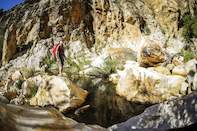Natural Caves
The Baviaanskloof region is blessed with numerous natural caves and Baviaanskloof rock art found in rock shelters, many of which were inhabited by the San, Khoi and KhoiSan over thousands of years.

In these shelters are remarkably well-preserved archaeological deposits and against the walls are numerous paintings. In general the paintings are not well-preserved and there are few large panels, probably due to the lack of large smooth areas to paint on.
The paintings appear to be in a similar ‘style’ throughout the region and the dominant colour is red and maroon red with black, yellow and white present in a lesser degree.
To the inexperienced eye the art may reflect depictions of hunting, running, fighting etc, but at closer examination one would notice that these scenes contain other aspects which illustrate the rituals, myths and beliefs of the painters. One such example is that human figures are often painted in ‘strange positions’ with lines from their noses and sometimes with animal features.
Rock Art Interpretation

As most of the painted images are believed to be related to the San shamanistic experience, these ‘strange postures’ are interpreted as shamans entering trance during ritual dances. Women in ‘dancing postures and/or clapping’, which are reminiscent with these dances, are often associated with ‘trance figures’.
For the painters, animals had far more value than only meat. They believed that each animal had its own spiritual power, some more than others, for example the eland in the Drakensberg played an important role in San rituals.
For the greater Baviaanskloof region such an animal could have been the elephant, because it appears frequently on the shelter walls. Other images may include hand prints, finger dots, geometric signs, ‘nets’ and many others, each with its own particular symbolic meaning.